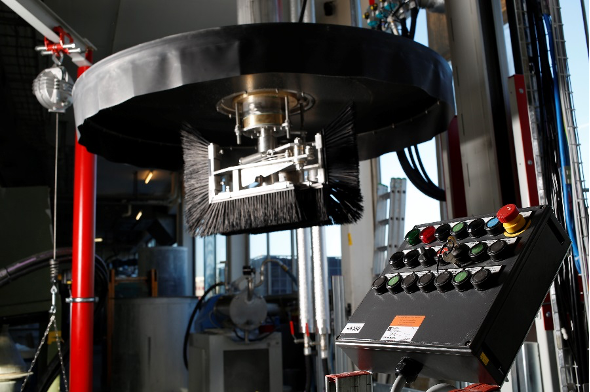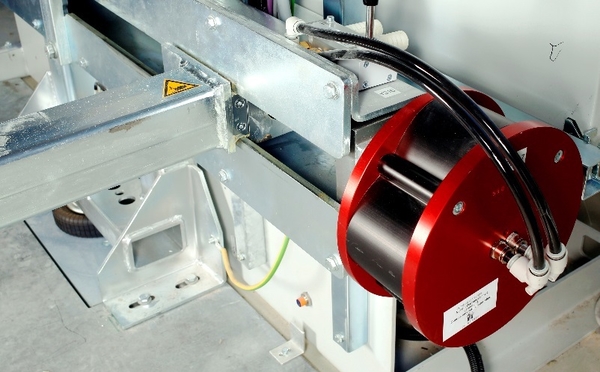The Technology
The CS-3x0x mixing vessel cleaning system cleans its mixing and batching vessels internally by means of speed-controlled centrifugal brushes with the aid of a suitable detergent. Mechanical cleaning by brushes is one of the most effective and efficient cleaning methods; it ensures them, together with an effective detergent, a residue-free result.
Our cleaning systems are modular in design. Even with the basic version, automatic cleaning operation is possible. Expansion stages and additional functions make our cleaning systems a total solution that meets their needs.
Wash and Rinsing Wash Media
The CS-3x0x modular mixing tank washing machine can be used to operate all washing and rinsing media available on the market up to an operating temperature of 60 °C, except for acidic detergents with a PH value below 5
Safety in handling detergents and rinsing agents
If detergents that form explosive aerosols when sprayed or flammable solvents are used in the cleaning process or if there are solvent-containing residues in the container, this area is considered ATEX Zone 0. The inside of the washing area (centrifugal brush, etc.) is therefore approved for ATEX Zone 0.
The solid content (2nd phase) in our cleaning systems in the washing agent can be up to 8% by volume, regardless of the conductivity.
With the CS-3x0x mixing container cleaning system from OFRU, you are making the right decision if you value thorough and efficient interior cleaning!
Product features of CS-3x0x
The tank cleaning equipment, type CS-3x0x has the following, main features:
- Optimally matched technology between the mechanical action and the washing and rinsing media used
- Completely separate piping system for wash and rinse ensure minimal rinse media consumption
- Solid pole with adjustable carriage
- Effective, speed-controlled centrifugal brush
- Effective pneumatically driven floor discharge brush
- Speed-controlled vertical movement for precise approach to problem areas
- Monitored washroom lid contact with integrated process exhaust port
- Foamed seal with electrically conductive, heavy-duty grid foil
- Removable bottom plate for faster spillage of residual materials and residual liquid
- Ergonomic discharge cleaning with integrated brush drive and return hose
- Highest personal safety due to safety-related measures
- Various program options to optimize the cleaning process
- Adjustable parameters for all operational interventions in the program
- Tailored and customer benefit focused expansion options
- Use-oriented and clear, technical documentation
Working Area Washing Machine Type CS-3x0x
| Machine Type | Unit | CS-3x01 | CS-3x02 |
|---|---|---|---|
| Inside diameter min. | mm | 600 | 750 |
| Diameter max. | mm | 1350 | 1500 |
| Inner height min. | mm | 700 | 700 |
| Inner height max. | mm | 1450 | 1450 |
| Total height min. | mm | 850 | 850 |
| Total height max. | mm | 1600 | 1600 |
| Distance from bottom min. | mm | 100 | 100 |
| Vessel total weight | kg | 700 | 700 |
| Bottom exit min. | ø | 1" | 1" |
Special design on request
Variants / Basic System
With Mixing Vessel Cleaning System CS-3x0x
| Mixing Vessel Cleaning Washing System, Type (Refer to offert) | CS-330x-atex | CS-340x-atex | CS-330x-atex | CS-340x- atex | CS-350x | CS-330x-atex-wvs | CS-340x atex-wvs | CS-350x-wvs |
|---|---|---|---|---|---|---|---|---|
| Flammable Cleaning Media approx. 20°C | X | X | ||||||
| Cleaning Media warm up to approx. 60°C | X | X | X | X | X | X | ||
| Washing suds, heated to 60°C | X | X | X | X | X | X | ||
| Brush System ATEX Zone 0 | X | X | X | X | X | X | X | X |
| ATEX Zone 1 | X | X | X | |||||
| ATEX Zone 2 | X | X | X | |||||
| Zone-free | X | X | ||||||
| Washing- Final Rinsing | X | X | X | X | X | |||
| Washing – Pre-Rinse - Final Rinsing | X | X | X | |||||
| Diaphragm Pump Washing | X | X | X | X | X | X | X | X |
| Diaphragm Pump Pre-Rinsing | X | X | X | |||||
| Diaphragm Pump Final Rinsing | X | X | X | X | X | X | X | X |
| 1 Back Flow Pump with Filter | X | X | X | X | X | |||
| 2 Back Flow Pump with 1 Filter | X | X | X | |||||
| Wash Pipe System | X | X | X | X | X | X | X | X |
| Rinse Pipe System | X | X | X | X | X | X | X | X |
| Aerosol Separator | X | X | X | X | X | X | ||
| Liquid Pipe Blow Out | X | X | X | X | X | X | X | X |
Special design on request
Technical data sheet / basic design
| Voltage A, VAC, 3-phase | V / Hz | 3 x 400 / 50 |
| Voltage B, VAC, 1-phase | V / Hz | 230 / 50 |
| Installed power | kW | 6 |
| Backup fuse | A | 25 |
| Minimum protection class | ≥ | IP 54 |
| Processor control | Type | Siemens / S7-1500 |
| Room temperatures | °C | 10-30 |
| Max. allowable temperature strip brushes | °C | <75 |
| Allowable operating temperature strip brushes | °C | <65 |
| Process exhaust air volume flow, total approx. | m3/h | 600 |
| Compressed air, dried, unlubricated | bar | 6 |
| Sound immission prediction * | dB(A) | <82 |
| Total weight approx | Kg | 3000 |
| Maximum floor load | kg/m2 | 960 |
* Depending on the building and other noise sources
Process description Basic system CS-3x0x
The CS-3x0x has an automatic process sequence. Cleaning times can be individually preselected by means of a selector switch. The entire process complies with the current safety requirements both in terms of personal protection and plant protection.
All process steps take place in a closed vessel. This minimizes the risk of accidents, as moving plant parts are out of the operator's reach. Odor and noise emissions are reduced to a minimum.
Container feed
The soiled container is placed between the clamping arms on the base plate and fixed with the clamping device. By means of a selector switch on the on-site control, the program options can be selected and the cleaning process started. The system is started via a 2-hand control unit.
Washing in circulation
With sufficient quantity and a defined pressure, the cleaning medium is sprayed through the spray nozzles to the rotating centrifugal brush. After washing, the centrifugal brush is freed from residual substances by means of increased speed and the piping system is blown out to prevent dripping.
Final rinse
The final rinse is used for the complete removal of residual substances and detergents left over from the washing process, but which have been completely dissolved. The final rinse is performed with fresh detergent. After the final rinse, the centrifugal brush is freed from residual substances by means of increased speed and the piping system is blown out to prevent dripping.
Container removal
By pressing the "OFF" key, the lid and centrifugal brush are lifted and the unit is moved back to the basic position. The clamping device is released and the clean container can be removed from the unit.
Optional expansion solution
Bottom outlet cleaning unit, 1 return line
The cleaning of bottom outlets incl. shut-off devices is an important part of the overall cleaning process. Residual contamination in this area can lead to incorrect batches. For complete and residue-free cleaning of ball valves, they must be disassembled and cleaned outside the washing plant.
Ergonomically operated, closed outlet cleaning unit made of stainless steel:
- Pneumatic brush drive with flexible shaft
- Electrically conductive, flexible PA monofilament brushes
- Transition adapter 3" to 2", without coupling
- Return connection with electrically conductive hose
- Ventilation connection (can be used for drying or forced ventilation)
- Solid steel post with C-profile rail and weight balancer for the complete unit
- Parking garage for the cleaning unit, incl. collecting tray
Container inclination
Mixing containers often have dented bottoms or outlets that are not welded in at the lowest point. A removable bottom plate is available for improved discharge. This process step is integrated into the automatic process sequence. This brings the container to a slope of 2°:
- Solid steel plate with mounted clamping and tensioning device
- Inclined position monitored by means of initiator; additional, mechanical, adjustable stop
- Special short stroke cylinders
- Automatic centering and clamping device
Especially in case of continuously changing container diameters or corresponding container weights, we recommend replacing the handwheel by a drive unit: - Powerful pneumatic drive motor, mounted on the TR spindle.
- Pneumatic actuating valve



